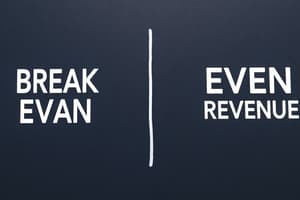Podcast
Questions and Answers
What does the horizontal line for fixed costs on a break-even chart represent?
What does the horizontal line for fixed costs on a break-even chart represent?
No change in fixed costs
Explain the significance of calculating the margin of safety in business.
Explain the significance of calculating the margin of safety in business.
It shows how much sales can fall without causing losses.
What are some limitations of using break-even analysis in decision-making?
What are some limitations of using break-even analysis in decision-making?
Not all costs can be easily categorized, and it assumes all output is sold.
How can a business use cost data to improve profitability?
How can a business use cost data to improve profitability?
How can managers use the concept of contribution in deciding on special orders?
How can managers use the concept of contribution in deciding on special orders?
Why is it important for managers to observe costs over time?
Why is it important for managers to observe costs over time?
What is the importance of break-even analysis?
What is the importance of break-even analysis?
Define break-even output.
Define break-even output.
How is break-even calculated?
How is break-even calculated?
What does the margin of safety represent in break-even analysis?
What does the margin of safety represent in break-even analysis?
Flashcards are hidden until you start studying
Study Notes
Fixed Costs on Break-even Chart
- The horizontal line indicates fixed costs, which remain constant regardless of the level of production or sales.
- This line helps visualize how fixed costs contribute to overall expenses and the establishment of the break-even point.
Margin of Safety
- Margin of safety measures the difference between actual sales and break-even sales.
- It indicates the risk of a business not meeting its breakeven point, providing insight into financial health and decision-making.
- A higher margin allows for greater flexibility in response to sales fluctuations.
Limitations of Break-even Analysis
- Assumes costs are either fixed or variable, disregarding semi-variable costs which can lead to inaccuracies.
- Does not consider external factors such as market changes, consumer preferences, or economic conditions.
- Single product focus can be misleading for businesses with diverse product lines, as it simplifies cost structures.
Using Cost Data to Improve Profitability
- Analyzing cost data helps identify inefficiencies and areas for cost reductions, leading to increased margins.
- Businesses can adjust pricing strategies based on variable costs to optimize profits.
- Understanding fixed vs. variable costs aids in making strategic decisions about scaling production or entering new markets.
Contribution in Special Orders
- Contribution margin represents the revenue remaining after variable costs are deducted, crucial for evaluating special order profitability.
- Managers can prioritize accepting orders with positive contributions, even if prices are below regular selling prices, as long as fixed costs are covered.
Importance of Observing Costs Over Time
- Tracking costs over time allows managers to identify trends and make informed projections for budgeting and forecasting.
- Enables proactive measures in managing expenses and adapting to market changes.
- Helps in understanding the long-term impact of decisions on profitability.
Importance of Break-even Analysis
- Serves as a foundational tool for determining the viability of businesses and products.
- Assists in financial planning, budget preparation, and addressing market risks.
- Provides clarity on the sales volume necessary to begin generating profit.
Break-even Output
- Break-even output is the level of production where total revenues equal total costs, resulting in neither profit nor loss.
- It quantifies the minimum sales needed to cover costs.
Break-even Calculation
- Break-even is calculated using the formula: Break-even point (in units) = Fixed Costs ÷ (Selling Price per Unit - Variable Cost per Unit).
- This calculation helps determine the sales volume required to achieve financial stability.
Margin of Safety in Break-even Analysis
- Represents the buffer or cushion between actual sales and the break-even sales threshold.
- Acts as a measure of risk, indicating how much sales can decline before the business reaches a loss.
Studying That Suits You
Use AI to generate personalized quizzes and flashcards to suit your learning preferences.




